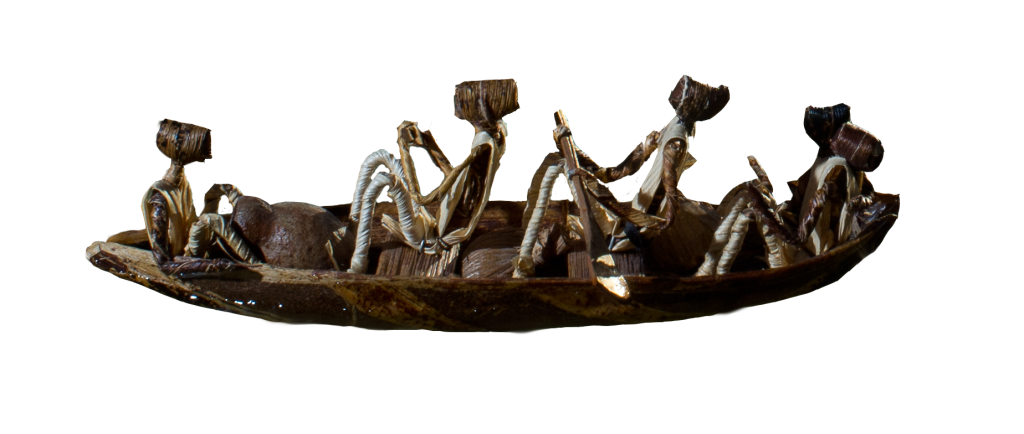Join us in supporting the Tembea Na Mimi walkers!
The walk starts on August 3rd and journeys over 150 miles to the shores of Lake Victoria.
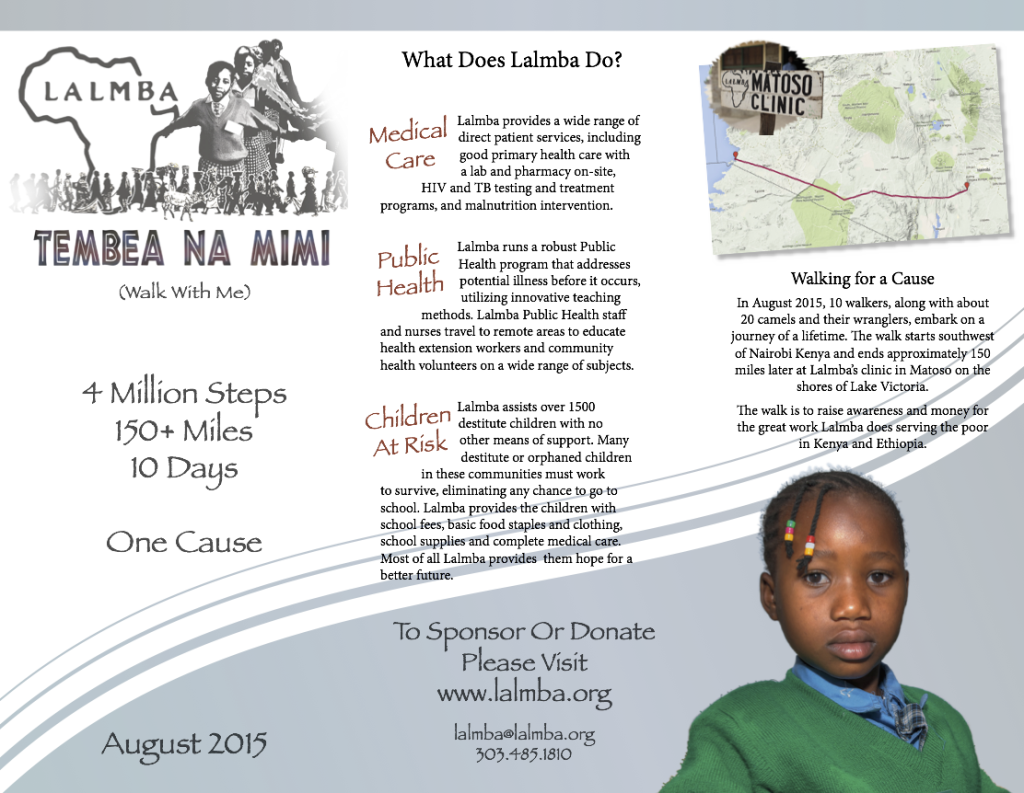
 |
By Jeff James
To see a person suffer is horrible, but to watch someone die of a treatable disease is unbearable. Yet this happens daily in the parts of Africa where we work. In these communities, quality health care is scarce, and recovery from a severe illness is rare. Every time someone gets better, it is a small miracle to celebrate.
I just returned from a visit to our project in Chiri, Ethiopia, the home of Lalmba’s Chiri Health Center (and the birthplace of coffee!). There I had the pleasure of going on rounds with our nurses and our volunteer medical director, Bob Roark.
Bob, a physician’s assistant from Denver, told me that visiting the inpatients, checking their vitals, and watching them progress to better health is what he enjoys most about this work. It’s the reason he got into medicine, to fight treatable disease in the poor.
Our hospital is very small, only 20 beds. Those who get admitted would most certainly die without our help. Quite literally, we are saving lives.
First stop, the SAM (Severe Acute Malnutrition) ward, the most heartbreaking place to visit. The children staying there are often close to death when they arrive, sick and weak.
Sadly, this ward is usually filled to capacity, and we are the only facility in the area that treats malnutrition.
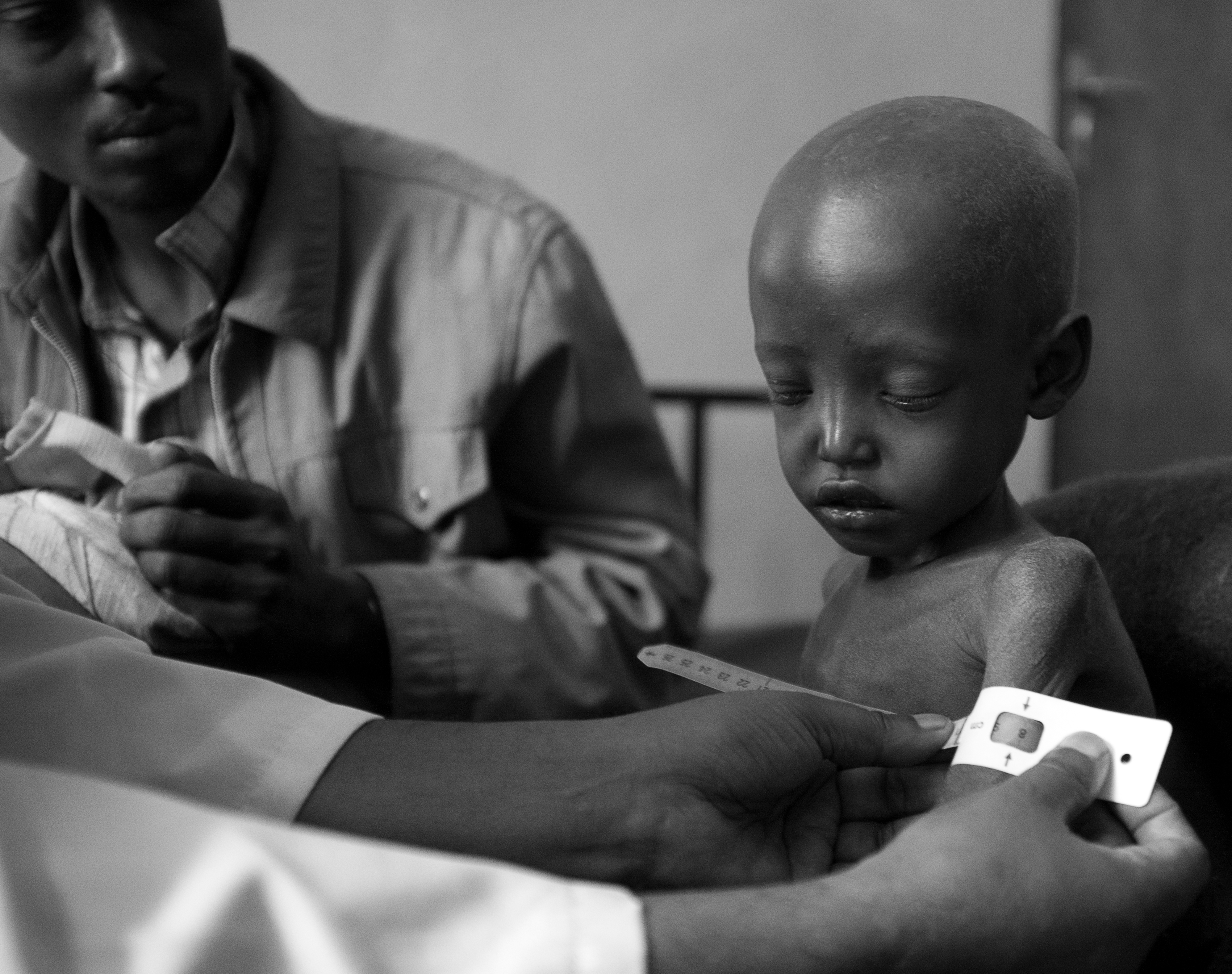 Of child deaths in Africa, 35% of them are related to malnutrition. It’s a huge problem where we are in Ethiopia. When a child is admitted into our program, we treat them for other illnesses while gradually upping their caloric intake, using a formula made at our health center. A critical element of our care is providing intensive education to the parent(s) on proper nutrition, so the malnutrition doesn’t recur.
Of child deaths in Africa, 35% of them are related to malnutrition. It’s a huge problem where we are in Ethiopia. When a child is admitted into our program, we treat them for other illnesses while gradually upping their caloric intake, using a formula made at our health center. A critical element of our care is providing intensive education to the parent(s) on proper nutrition, so the malnutrition doesn’t recur.
Also in the hospital this day, in our isolation ward, was a man with acute meningitis. He was admitted close to death, vomiting with a high fever. After 3 days of IV antibiotics, he was sitting up in bed with a faint smile on his face—a smile that spread throughout the room. Without Chiri Health Center he would have died.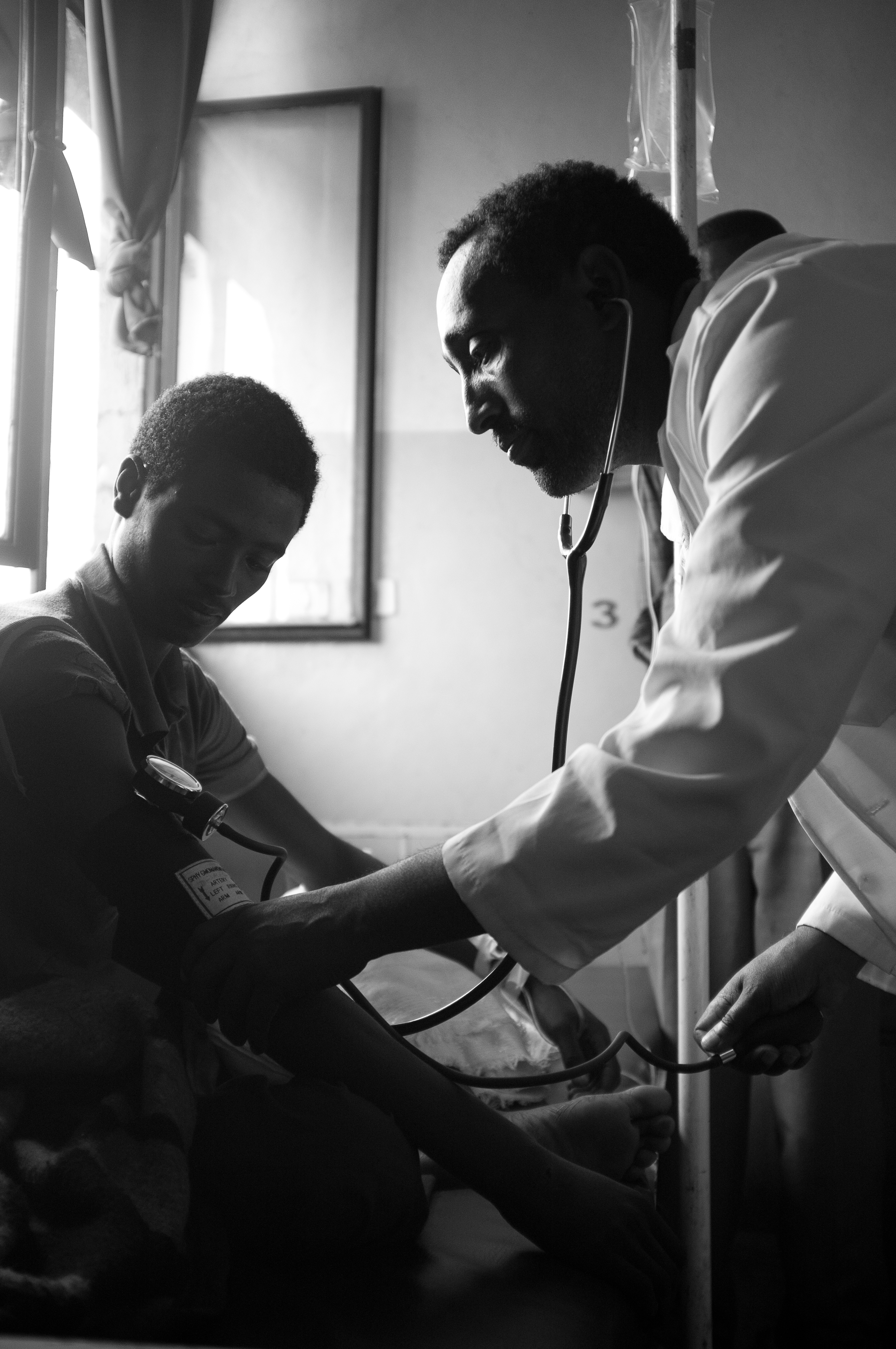
There was a patient just diagnosed with cutaneous tuberculosis. He was destitute and his home was many hours’ walk from our health center. From past experience, we know that patients like him usually do not complete their course of treatment. They have mouths to feed and land to farm. Health guidelines do not allow patients to take medicine home with them, and the daily distance is just too far to walk every day. Because the risk of disease transmission is so great if TB is not treated, we find a place to stay for these patients and provide them with daily meals for the first month of treatment. Without a program like ours, TB continues to spread through these communities.
There was a young mother who had developed some sort of paralysis from the waist down. We referred her to the Missionaries of Charity for further tests. She asked us to keep her 2 year-old for her, and we agreed to temporarily care for him in our children’s home until she could return to Chiri. There was no one else to take in the child.
Yes, we are saving lives daily, but we couldn’t do any of it without you, our donors.
The old adage “prevention is the best medicine” is certainly true. Our public health teams teach how to prevent disease, an even more powerful gift than curing it. Likewise, Lalmba’s health is maintained through wise spending plans and fundraising goals. Since 2007, however, donations have declined, and we have been operating at a deficit, spending from reserves, hoping that donations will improve. But things haven’t improved, and so to protect the health of Lalmba for future generations, we had to make some difficult budget cuts this year, reducing the scope of some of our work. So far, we have been able to maintain the mission-critical aspects of our programs.
As a nonprofit, we are not alone in this struggle. Many organizations are feeling the effects of a worldwide decline in charitable giving. But we’re used to challenges, and our resolve for this mission is as strong as ever.
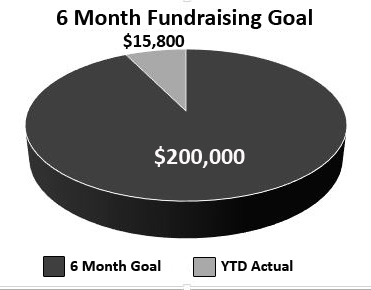 How can you help? Maybe you could increase your donations this year. Perhaps you could talk about Lalmba to your friends and family. Maybe you belong to a group that is looking for speakers. You could invite us to come and talk about the work of Lalmba. We promise to not only be informative, but also entertaining. (Hillary is learning to juggle, and I’ve got a couple of “knock-knock” jokes up my sleeve!)?
How can you help? Maybe you could increase your donations this year. Perhaps you could talk about Lalmba to your friends and family. Maybe you belong to a group that is looking for speakers. You could invite us to come and talk about the work of Lalmba. We promise to not only be informative, but also entertaining. (Hillary is learning to juggle, and I’ve got a couple of “knock-knock” jokes up my sleeve!)?
Or maybe . . . you have a different idea?
The bottom line is, we all love Lalmba because of the work Lalmba does for the poor who have nowhere else to go. And we all want to see this work continue. But for that to happen we need to be creative. We need to be bold enough to ask for help when we need it, and now is that time.
Our goal is to raise $200,000 by July 1 in order not to make additional program cuts this year. It’s a tall order, but we’re praying that with your help, Lalmba can thrive for another 50 years.
 Don’t forget . . . Tembea Na Mimi.
Don’t forget . . . Tembea Na Mimi.Walk across Kenya happens the first two weeks in August. We’re still looking for a couple more people to walk across the RiftValley with us. Call or email me if your feet were made for walking!
 Lalmba has partnered with Cars for Charity, a nonprofit that takes old cars and turns them into cash for the charity of your choice. If you have an old car, please contact Cars for Charity and let them know that you have a car donation for Lalmba Association. Lalmba has partnered with Cars for Charity, a nonprofit that takes old cars and turns them into cash for the charity of your choice. If you have an old car, please contact Cars for Charity and let them know that you have a car donation for Lalmba Association.
Website: http://www.carsforcharity.net/Phone Number: 303-853-4483 |
CHRISTMAS TIME’S A’COMIN’…GET YOUR FAIR TRADE SHOPPING DONE RIGHT HERE!Hand-crafted boats made from banana leaves, delivered straight from the workman’s bench in rural Kenya, are now available to you for the annual Lalmba $100 Christmas Fundraiser Extravaganza! This year’s gift is particularly meaningful because of our work in a little village on the shores of Lake Victoria. Lake Victoria itself is statistically impressive. It’s the largest lake on the continent, and the world’s second-largest freshwater lake. It’s so large it extends into three separate countries: Uganda, Tanzania and Kenya. For the community, the lake is the source of all livelihood. Every night the lake is dotted with fishing boats trying to catch Nile perch or tilapia. A good haul means enough money to feed the family for another week. A poor catch means another week of struggle. You’d be surprised how flimsy people’s fishing boats are, particularly as the waves on the lake can rival ocean waves in a storm. If a storm hits while the fishermen are on the lake, they just cover their boats with a tarp and lie down flat in the bottom of the boat to wait it out. Seasickness is a common affliction for the fishermen. I was recently told that if you get seasick out on the lake, you should drink the stagnant water pooled on the bottom of the boat to cure yourself. Hmm…well at least then if you feel sick, you can’t blame your seasickness anymore! We hope you enjoy the boats. They really do float! Want to see the lake for yourself? If you’re a hardy and adventurous soul, check out Jeff’s plan at the bottom of this post! |
Founders’ Cornerby Hugh Downey (in Africa) SEASON OF CHANGE AT HOME IN NYAGRIBE It is early winter for you good people back in North America. But here in Africa it is a time of no change. Our home here is 1 degree south of the equator and the only seasonal change is from dry to wet – then back again. We are anxiously awaiting the rains as local farmers depend on this season to raise their crops. Our home here consists of 3 grass huts. There is no electricity for lights. We use candles after dark. Cooking is done on a small propane stove. The rhythm of life is controlled by the sun. Being ‘equatorial’, we have almost exactly 12 hours of sun followed by dusk and darkness. It does take some getting used to, but we find that it provides a reasonably comfortable life. BOATS AND BOATMEN Our 3 huts face Lake Victoria and for much of the day we observe boatmen paddling their little boats along the shore. Most are fishermen. Others use their boats for transportation or for moving goods. I recall one day recently when I saw a small boat moving an entire household . . . beds, chairs, cooking equipment, followed by another boat carrying the family. I was reminded of ‘moving day’ back in the U. S. where families load their belongings onto a truck and follow in the family car. THE $100 BOAT Boats are at the center of life in this part of Africa. This year, Jeff and Hillary have chosen a small replica of the boat as a Christmas gift for you. I have one such boat in my house back in the U. S. and always receive comments from visitors. It is not so much the boat which you purchase, but the knowledge that you provide life-saving medicines for the sick and education for children. This is Lalmba’s largest source of income during the year; we have been blessed with so many of you who have participated. We encourage you to continue to purchase our clever little gifts. It is actually a gift of life which you share with many needy people in our world. As always, Marty joins me in wishing you a very blessed Christmas. |
IN BRIEFHILLARY’S FIELD NOTES
Kim and I journeyed to one such outlying village, a 4 hour ride on horseback, to evaluate the need there. We picked the muddiest week of the year, our horses sinking into leg-deep mud at times. The trip, to an area completely unfamiliar with development, inspired us to continue stretching to those roadless places, those communities that still suffer from such extreme poverty that it breaks our hearts. THE PRICE OF GENIUSIn case you wondered about Jeff’s dedication to this work, check out how he managed to get the perfect picture of these beautiful banana leaf boats floating along! In related news . . . A Strange VisitorAlso on my trip I had the honor of hosting a Lalmba supporter named Jim Crum, a professional videographer from Los Angeles. He was on safari in Kenya, and offered to come to Matoso to shoot a video for our website. He was a colorful character, standing 6’4” (even taller with his camera gear and microphone) and he braved a terrible invasion of lake flies, hitting his head numerous times on the roof of his sleeping hut, lukewarm beer and locals who didn’t quite understand the meaning of ‘act natural’! We are so grateful to Jim for volunteering his time and comfort to live with us for a week. Please look for the Lalmba video on our website in the next few months. |
Tembea Na Mimiby Jeff James Our Walk With Me fundraiser was a big success. For those of you who participated, thank you! You helped us raise nearly $30,000 by walking and sponsoring our walking friends in Africa on our 51st anniversary, Sept. 21. Check out these numbers: EthiopiaAsrat = 31,074 steps Asede = 37,080 steps Gezahign = 11,884 steps Netsanet = 14,082 steps KenyaQuinter = 30,067 steps Peter = 28,918 steps Joshua = 9,412 steps Stateside, we also had a few super walkers. I walked from our home in Longmont to Denver’s City of Nairobi Park, logging 72,172 steps. I was joined along the way by Terry Robinette, who walked the final 10 miles (about 25,000 steps). And longtime Lalmba friend, volunteer, and donor Rob Andzik, walked from his home in Monument, CO to Denver to join me for a celebratory picnic in the park. Rob walked an incredible 72,264 steps. Asante sana kwa tembea na mimi! |
Tembea Na Wazimu(Walk with Crazy) It’s really not that crazy; it’s simply the adventure of a lifetime. In August 2015, up to 10 Lalmba ambassadors will walk from a place called Olepolos (about 60 km south of Narok) westward across the Rift Valley to Lalmba’s project on the shore of Lake Victoria. We will pass through the north Maasai Mara nature conservancy, some of Kenya’s most pristine landscape with an incredible chance to see wildlife intimately but safely. This journey will take about 10 days, and we will walk about 15-20 miles per day with a caravan of about 18 camels. We’ve had many people express interest in this trip, but now it’s time to commit. If you’re interested, please contact me right away to reserve your spot or to get more information. This route is subject to change, depending on how negotiations go with local chiefs. But it is the ideal route for those who care about the work of Lalmba, because it allows you to see firsthand our work and the people we serve. Please give me a call or shoot me an email so that I can fill you in on the details. If you’ve got the time, money, good health, a great sense of adventure and cultural curiosity, this safari was made for you. Tembea na mimi! |
